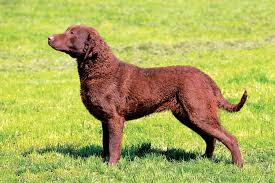
Chesapeake Bay Retriever
Conditions of detention
The Chesapeake Bay Retriever adapts well to various living conditions, but they thrive in homes where they have plenty of space to exercise and access to water for swimming.
Useful Fact: These dogs are highly active and require regular outdoor activities, making them ideal for families with active lifestyles and homes near water bodies.
Nutrition and diet
A balanced diet rich in protein and essential nutrients is crucial for maintaining the health and energy levels of the Chesapeake Bay Retriever.
Useful Fact: High-quality commercial dog food or a carefully planned homemade diet can meet their nutritional needs. Regular monitoring of their weight helps maintain optimal health and prevent obesity.
Health
The Chesapeake Bay Retriever is generally a healthy breed but can be prone to hip dysplasia, elbow dysplasia, and eye conditions.
Useful Fact: Regular veterinary check-ups and genetic screenings can help detect and manage potential health issues early, ensuring a longer, healthier life for your dog.
Grooming and care
The Chesapeake Bay Retriever has a dense, waterproof double coat that is short and harsh to the touch, providing excellent protection in cold water. Common coat colors include shades of brown, sedge, and deadgrass.
Useful Fact: Regular brushing, at least once a week, helps remove loose hair and keep the coat healthy. More frequent grooming may be necessary during seasonal shedding periods.
Education and training
Chesapeake Bay Retrievers are intelligent and eager to please but can be independent and strong-willed. Consistent, positive reinforcement training is essential.
Useful Fact: Early socialization and training are crucial to channel their energy and intelligence into constructive activities, preventing behavioral issues.
Toys and entertainment
These dogs enjoy activities that stimulate their mind and body, such as fetch, swimming, and agility exercises.
Useful Fact: Providing water-based activities and toys designed for retrieving can help keep them mentally stimulated and physically fit, preventing boredom-related behaviors.
Safety
Chesapeake Bay Retrievers are strong and active, requiring supervision during outdoor activities to ensure their safety.
Useful Fact: Secure fencing in the yard is vital to prevent them from wandering off or chasing after wildlife, ensuring their safety.
Accessories
Durable collars, leashes, and harnesses are essential, along with sturdy food and water bowls and a comfortable bed.
Useful Fact: Using a well-fitted harness during walks can provide better control and is often more comfortable for these active dogs than a collar alone.
Socialization
Early and consistent socialization with a variety of people, animals, and environments helps ensure a well-rounded and balanced temperament.
Useful Fact: Puppy classes and regular exposure to new experiences can significantly improve their social skills and confidence, making them well-adjusted adults.
Travel and Transportation
Chesapeake Bay Retrievers can travel well if accustomed to it from a young age. Ensure they are comfortable and secure during travel.
Useful Fact: Using a spacious crate or dog seat belt can enhance safety and comfort during car rides, reducing anxiety and ensuring a pleasant travel experience.
Behavior and psychology
These dogs are loyal, friendly, and enjoy being close to their owners. They thrive on companionship and need regular mental and physical stimulation.
Useful Fact: Understanding their need for activity and social interaction can help in providing appropriate outlets for their energy, such as obedience training, agility courses, or interactive play.
Legal aspects
Check local regulations regarding dog ownership, including vaccination requirements, leash laws, and registration.
Useful Fact: Some areas may have specific regulations regarding dog breeds and their care, so it’s important to be aware of and comply with local laws to avoid legal issues.


